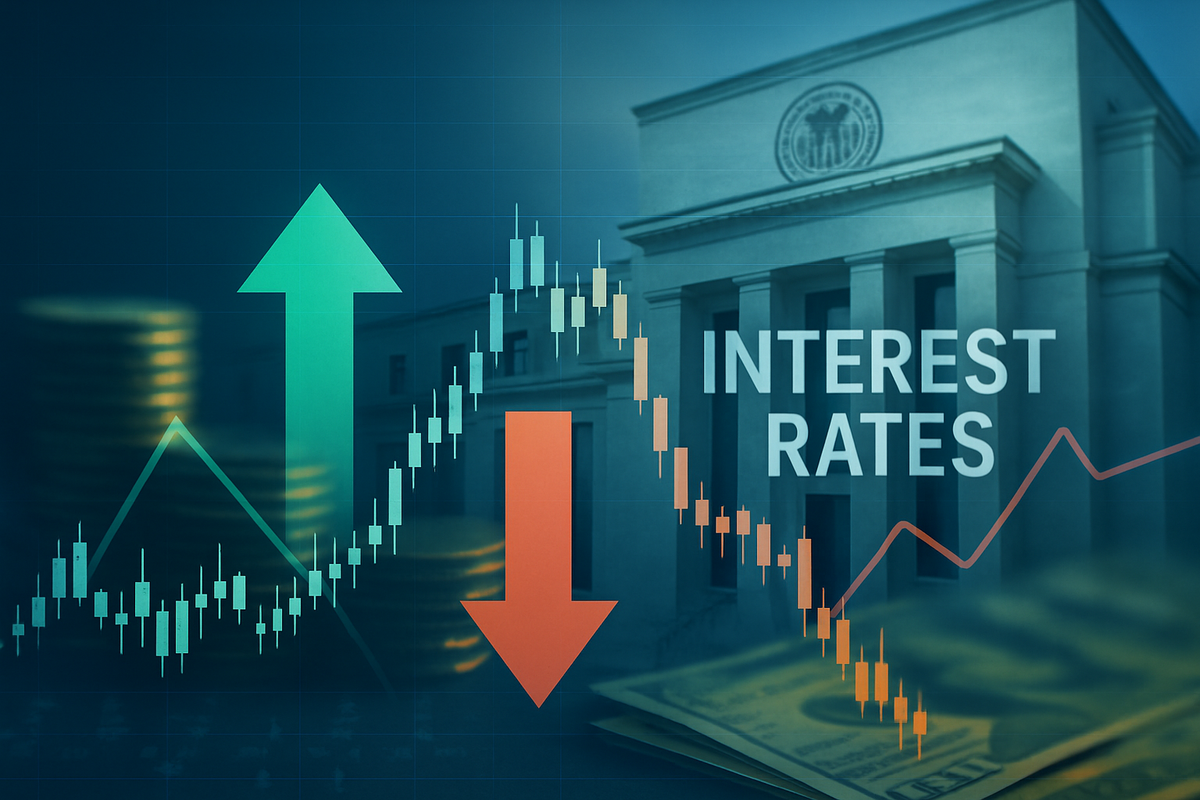
The financial markets are currently flashing a near 100% probability of a Federal Reserve interest rate cut at the upcoming October 28-29 Federal Open Market Committee (FOMC) meeting. This overwhelming market conviction, largely driven by a softening labor market, the Fed's recent pivot towards an easing monetary policy, and persistent, albeit elevated, inflation, is sending clear signals about the future trajectory of the U.S. economy and the investment landscape. Such a strong market expectation suggests that investors are bracing for a significant shift in monetary policy, with profound implications for everything from borrowing costs to corporate earnings.
This anticipated move reflects a broader recalibration of economic expectations, as policymakers navigate a complex environment marked by decelerating growth, a fragile job market, and inflation that remains above the central bank's comfort zone. The near certainty of a rate cut underscores the market's belief that the Fed is prioritizing support for the labor market and economic stability, even as it continues its battle against inflation. For investors, this moment presents both opportunities and challenges, requiring a careful assessment of how lower interest rates will ripple through various sectors and asset classes.
The Inevitable Easing: A Deep Dive into Market Sentiment and Fed's Stance
The overwhelming market sentiment for a Federal Reserve interest rate cut is not merely speculative; it is deeply rooted in recent economic data, the Fed's own communications, and sophisticated market-based probability tools. As of October 9, 2025, the CME FedWatch Tool indicates an astonishing 93% to 100% probability of a 25-basis-point (bps) rate cut at the upcoming October FOMC meeting, which would place the federal funds rate in the range of 3.75% to 4.00%. This strong conviction extends to year-end, with expectations for at least one more 25 bps cut in December.
The timeline leading to this moment has been characterized by a confluence of economic shifts. The U.S. labor market has shown clear signs of softening, with August employment data revealing a paltry 22,000 jobs added and the unemployment rate climbing to 4.3%—its highest level since 2021. Weekly jobless claims have also been disrupted by an ongoing government shutdown, further clouding the picture but reinforcing concerns about labor market instability. While inflation remains above the Fed's 2% target, with the Consumer Price Index (CPI) at 2.9% year-over-year in August and the Personal Consumption Expenditure (PCE) index at 2.7%, the Fed appears to be increasingly focused on supporting employment. Moderating GDP growth, with Q4 2025 projections slowing to just 1.2% year-over-year after a revised 3.8% in Q2, further solidifies the case for easing.
Key players involved in this unfolding scenario include the Federal Reserve's FOMC members, who have already initiated an easing cycle with a 25-basis-point cut in September 2025, bringing the federal funds rate to 4.00%-4.25%. This was the first reduction since December 2024. Minutes from the September meeting reveal a dual focus: a commitment to the 2% inflation target alongside increasing concerns about the weakening labor market. The September cut was widely interpreted as a "risk management cut" aimed at bolstering employment and preventing a deeper economic slowdown. While some officials, like Governor Michael Barr, have urged caution, the predominant sentiment within the Fed points towards further easing. Initial market reactions to these signals have included fluctuations in bond yields, stock futures, and the U.S. dollar, as investors rapidly adjust their portfolios to the prospect of cheaper money.
Companies on the Cusp: Winners and Losers in a Lower Rate Environment
A Federal Reserve interest rate cut, especially one so strongly anticipated, will inevitably create a distinct divide between winning and losing companies in the financial markets. The immediate beneficiaries are likely to be companies that thrive on lower borrowing costs and increased consumer spending, while those sensitive to shrinking net interest margins or reduced demand for conservative investments may face headwinds.
Potential Winners:
- Growth Stocks and Technology Companies: Companies with high growth potential, often in the technology (NASDAQ: NDX) and innovation sectors, typically benefit significantly from lower interest rates. Their future earnings are discounted at a lower rate, making their valuations more attractive. Furthermore, these companies often rely on debt financing for expansion and research, making cheaper capital a major advantage. Examples could include high-growth software firms or biotechnology companies (NASDAQ: IBB) that require substantial investment.
- Real Estate and Construction: The real estate sector (NYSE: XLRE) is highly sensitive to interest rates. Lower rates translate to more affordable mortgages, stimulating housing demand and property sales. This, in turn, boosts homebuilders (NYSE: ITB), real estate developers, and related industries like building materials and home furnishings. Companies like Lennar Corporation (NYSE: LEN) or D.R. Horton (NYSE: DHI) could see increased activity.
- Highly Leveraged Companies: Businesses carrying significant debt burdens will see their interest expenses decrease, improving their profitability and cash flow. This can provide a much-needed reprieve for companies that have struggled with higher financing costs during the tightening cycle.
- Consumer Discretionary: Lower borrowing costs can encourage consumers to take on more debt for big-ticket items like cars or homes, and generally increase disposable income, boosting sectors like retail (NYSE: XRT), travel, and leisure. Companies like Amazon (NASDAQ: AMZN) or various hospitality chains could see a lift.
Potential Losers:
- Banks and Financial Institutions: While lower rates can stimulate lending activity, they also compress net interest margins (NIMs)—the difference between what banks earn on loans and what they pay on deposits. This can negatively impact the profitability of traditional banks (NYSE: KBE) like JPMorgan Chase (NYSE: JPM) or Bank of America (NYSE: BAC), which rely heavily on NIMs for revenue.
- Utility Companies and Dividend Stocks: These sectors are often favored for their stable dividends and defensive characteristics. In a lower-rate environment, their appeal might diminish as investors seek higher returns in growth-oriented assets, and the yield spread over risk-free assets narrows.
- Companies with Strong Cash Positions: While not necessarily "losers," companies holding large amounts of cash or short-term investments may see reduced interest income on those holdings, slightly impacting their overall financial performance.
The impact will vary based on each company's balance sheet, growth prospects, and sector-specific sensitivities, but the general trend favors growth over value in a declining rate environment.
Wider Significance: A New Chapter in Economic Policy
The near-certainty of a Federal Reserve interest rate cut marks a pivotal moment, signaling a new chapter in economic policy and fitting into broader industry trends. This move represents a clear shift from a period of aggressive monetary tightening, aimed at combating inflation, to an easing cycle designed to support a softening economy and a fragile labor market. This pivot is not isolated but is part of a global trend where several central banks are contemplating or have already begun to ease monetary policy in response to decelerating growth and managed inflation.
The potential ripple effects of this policy shift are extensive. For businesses, lower borrowing costs could stimulate corporate investment and expansion, fostering innovation and job creation. Consumers might see a reduction in interest rates on credit cards and loans, potentially boosting spending and supporting economic activity. However, it could also reignite concerns about asset bubbles if liquidity becomes too abundant. Internationally, a weaker U.S. dollar, often a consequence of lower rates, could make American exports more competitive and benefit multinational corporations with significant overseas operations. Emerging markets might also see increased capital flows as investors seek higher yields outside the U.S.
From a regulatory and policy perspective, this decision highlights the Fed's delicate balancing act between its dual mandate of maximizing employment and maintaining price stability. The perceived prioritization of labor market support, even with inflation still above target, suggests a more dovish stance. This could lead to increased scrutiny from policymakers regarding the Fed's independence and its long-term inflation commitment. Historically, periods of rate cuts have often followed economic slowdowns or recessions, aiming to inject liquidity and stimulate recovery. Comparing this to similar events, such as the easing cycles after the dot-com bubble or the 2008 financial crisis, provides a framework for understanding potential outcomes, though each economic environment presents unique challenges. This time, the persistent inflation adds a layer of complexity not always present in previous easing cycles.
What Comes Next: Navigating the Evolving Market Landscape
As the financial markets brace for a near-certain Federal Reserve interest rate cut, the immediate and long-term implications for the economy and investors are substantial, opening up a spectrum of possibilities and challenges. In the short term, the market's strong expectation of a cut could already be priced into asset values, but the actual announcement and subsequent forward guidance from the Fed will be crucial. We can expect continued volatility as investors recalibrate portfolios, potentially favoring growth stocks and sectors sensitive to interest rates, such as technology and real estate. Bond yields are likely to remain subdued, and the U.S. dollar may weaken further, impacting global trade and currency markets.
Looking further ahead, the long-term possibilities hinge on whether these rate cuts effectively stimulate economic growth without reigniting inflationary pressures. If the Fed manages a "soft landing," avoiding a recession while bringing inflation down, we could see a sustained period of moderate growth. However, if inflation proves stickier than anticipated, or if the rate cuts are insufficient to counter economic headwinds, the Fed might face difficult choices, potentially leading to further easing or even a reversal of policy. Corporations will need to adapt their strategic pivots, focusing on optimizing capital structures, pursuing expansion opportunities with cheaper financing, and potentially re-evaluating their global supply chains in response to currency shifts.
Market opportunities will likely emerge in sectors poised to benefit from lower borrowing costs and increased consumer confidence. This includes areas like housing, consumer discretionary, and certain segments of the financial sector that can capitalize on increased lending activity despite compressed margins. Conversely, challenges may arise for investors heavily exposed to traditional income-generating assets or sectors that thrive in higher interest rate environments. Potential scenarios range from a robust economic recovery driven by accommodative policy to a more protracted period of slow growth if underlying structural issues persist. Investors should closely monitor key economic indicators such as inflation data, employment reports, and consumer spending trends to gauge the effectiveness of the Fed's policy and adjust their strategies accordingly.
Comprehensive Wrap-Up: A Market at a Crossroads
The financial markets' near 100% probability signal for a Federal Reserve interest rate cut marks a significant inflection point, underscoring a critical shift in monetary policy aimed at bolstering a softening economy. The key takeaway is the Fed's apparent prioritization of labor market stability and economic growth, even as it continues to grapple with inflation that remains above its target. This strong market sentiment reflects a consensus view that economic conditions necessitate cheaper capital, moving the market away from the tightening cycle of recent years.
Moving forward, the market will be characterized by heightened sensitivity to economic data releases and Federal Reserve communications. While a rate cut is largely priced in, the guidance accompanying the decision, particularly regarding future cuts, will dictate market reactions. Investors should assess the market's trajectory through the lens of a lower-rate environment, which typically favors growth-oriented assets and sectors over defensive ones. The enduring impact of this policy pivot will depend on its ability to stimulate sustainable economic growth without triggering a resurgence of inflation, a delicate balance that the Fed must master.
For investors, the coming months will require vigilance and strategic re-evaluation. Key aspects to watch for include the actual pace and magnitude of future rate cuts, the trajectory of inflation and unemployment, and corporate earnings reports, particularly from interest-rate-sensitive sectors. Opportunities may arise in real estate, technology, and consumer discretionary, while traditional income-focused investments might see their appeal wane. This period presents both risks and rewards, demanding a nuanced approach to portfolio management as the economy navigates this new monetary landscape.
This content is intended for informational purposes only and is not financial advice






